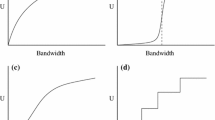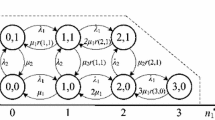Abstract
Modern communication networks evolve towards integration of guaranteed-performance and best-effort service types. The coexistence of these two service types offers substantial benefits, such as resource sharing between service classes, and the ability of the user to select an appropriate service class according to its individual requirements and preferences. Notwithstanding, such interaction gives rise to more complicated system behavior and related performance issues, which need to be explored and understood in order to allow efficient network operation. In this paper we examine potential congestion phenomena, which arise due to the combined effect of bandwidth sharing and user migration between service classes. We propose a simplified fluid model for session flow, consisting of two coupled queues with state-dependent flows, which captures the essential ingredients of service-class interaction. Our analysis shows that the system might exhibit bistable behavior, in the sense that transient congestion may stir the system from a stable and efficient operating point to an inefficient and congested one. We identify conditions which give rise to bistability, and propose a call admission control scheme which prevents the system from getting trapped in a congested-type equilibrium, while not interfering with normal system operation.
Similar content being viewed by others
References
G. Apostolopoulos, R. Guérin, S. Kamat, A. Orda, T. Przygienda and D. Williams, QoS routing mechanisms and OSPF extensions, Internet RFC 2676, Internet Engineering Task Force (1999).
R. Braden, L. Zhang, S. Berson, S. Herzog and S. Jamin, Resource reservation protocol (RSVP) - version 1 functional specification, Internet RFC 2205, Internet Engineering Task Force (1997).
J.D. Dai and S.P. Meyn, Stability and convergence of moments for multi-class queuing networks via fluid limit models, IEEE Trans.Automat.Control 40 (1995) 1889–1904.
W. Hahn, Stability of Motion (Springer, Berlin, 1967).
A. Mandelbaum and G. Patz, State-dependent stochastic networks, part I: Approximations and applications with continuous diffusion limits, Ann.Appl.Probab. 8 (1998) 569–646.
R. Rom and M. Sidi, Multiple Access Protocols (Springer, Berlin, 1990).
S. Shenker, C. Partridge and R. Guérin, Specification of guaranteed quality of service, Internet RFC 2212, Internet Engineering Task Force (September 1997).
Traffic management specification, Version 4.0, The ATM Forum Technical Committee (April 1996).
M. Vidyasagar, Nonlinear Systems Analysis, 2nd ed. (Prentice-Hall, Englewood Cliffs, NJ, 1993).
Author information
Authors and Affiliations
Rights and permissions
About this article
Cite this article
Altman, E., Orda, A. & Shimkin, N. Bandwidth allocation for guaranteed versus best effort service categories. Queueing Systems 36, 89–105 (2000). https://doi.org/10.1023/A:1019174918263
Issue Date:
DOI: https://doi.org/10.1023/A:1019174918263




